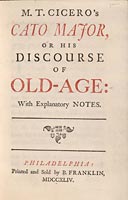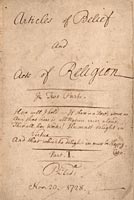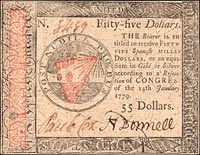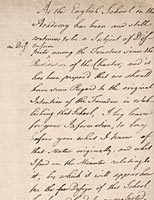Sections: Introduction - A Cause For Revolution - Break With Britain - Continental Congress
Treaty of Paris - The New Republic - Scientist and Inventor - Printer and Writer - Epitaph
Printer and Writer
For most people, Franklin's fame as a writer and printer rests on Poor Richard's Almanack which is commonly recognized for the wit and wisdom spun by Franklin under the pseudonym Richard Saunders. But Benjamin Franklin's accomplishments were far greater. He was considered the most accomplished printer in Colonial America. His 1744 edition of Cicero's Cato Major . . . is the finest example of early American printing. Not content with a successful career as a writer/printer, Franklin promoted a host of Philadelphia educational and benevolent societies including the founding of the city's first lending library.
A Masterwork of PrintingM.T. Cicero's Cato Major, Franklin's personal favorite from his press, is considered to be the finest example of the printing art in colonial America. Furthermore, this work by the Roman philosopher statesman Cicero is the first classic work translated and printed in North America. In his "Printer to the Reader," Franklin explains that he has printed this piece "in a large and fair Character, that those who begin to think on the Subject of old-age, . . . may not, in Reading by the Pain small Letters give the Eyes, feel the Pleasure of the Mind in the least allayed." |
|
|||||||||
|
One of the America's First MagazinesFranklin was the first to propose a monthly magazine for the American colonies. John Webb, whom Franklin had hoped to engage as editor, shared these plans with Franklin's rival, Andrew Bradford, and those two decided to publish a magazine. Both printers issued their first number in February 1741. Bradford's American Magazine, which may have beaten Franklin's General Magazine by a few days, lasted only three issues, while Franklin's magazine survived for six. |
|||||||||
Promoting Useful KnowledgeThis rare broadsheet is the founding document of the American Philosophical Society, the oldest scientific society in America. Franklin proposed that Philadelphia members would exchange information and ideas regarding all fields of natural and applied science and correspond with members in other colonies and countries about practical matters to benefit their lives and improve mankind. Franklin served as society secretary during the early years, and later as president, when regular correspondence was established with the Royal Societies of London and Dublin. Franklin encouraged communication between the learned societies to continue even during the Revolution. |
|
|||||||||
|
Benjamin Franklin's Personal LiturgyBenjamin Franklin asserted in his autobiography that he had quickly tired of formal religious services, but that early in life he had written his own private articles of religious belief and a simple liturgy to be read on Sundays. |
|||||||||
Ephrata Community SongbookFounder of the German Seventh-Day Baptists Johann Conrad Beissel immigrated with the community to Ephrata, Pennsylvania, in 1732. Beissel served as the spiritual director of the group as well as its composer, devising his own system of composition. The group's illuminated musical manuscripts were hand-lettered in Fraktur and are among the earliest original music composed in the British colonies. This illustrated hymnal was once in the possession of Benjamin Franklin. The rare second compilation of Beissel's hymns was printed in roman type without music by Benjamin Franklin in 1732. |
||||||||||
|
|
|||||||||
Printed CurrencySoon after establishing himself as an independent printer, Benjamin Franklin was awarded the "very profitable Jobb" of printing Pennsylvania bills of credit, partly because he had written and published a pamphlet on the need for paper currency in 1729. He was similarly employed by New Jersey and Delaware. Aware of the threat from counterfeiters, Franklin devised the use of mica in the paper and leaf imprints as ways to foil counterfeiters--both of these methods can be seen in these samples of currency printed by Franklin and his partner David Hall and later by the firm of Hall and William Sellers. |
||||||||||
|
||||||||||
|
The Art of Making MoneyThis humorous rendition of Franklin's teaching that honesty, industry, and frugality are the keys to full pockets has continued to be a popular souvenir since it was first printed as a rebus in 1791. Here the familiar image of Franklin in a fur cap is one that introduced Franklin to France in 1777. |
|||||||||
Franklin's First BookWhile working as a printer in London, Franklin published his first pamphlet at nineteen. In this metaphysical piece, a reply to William Wollaston's The Religion of Nature Delineated, Franklin argued that if God was infinite wisdom and goodness, vice and virtue were empty distinctions. After distributing a few copies to his friends, Franklin became disenchanted with his reasoning and destroyed all remaining copies but one. |
|
|||||||||
|
Poor Richard's AlmanackAs a writer, Franklin was best known for the wit and wisdom he shared with the readers of his popular almanac, Poor Richard, under the pseudonym "Richard Saunders." In his autobiography, Franklin notes that he began publishing his almanac in 1732 and continued for twenty-five years: "I endeavour'd to make it both entertaining and useful, and it accordingly came to be in such Demand that I reap'd considerable Profit from it, vending annually near ten Thousand." |
|||||||||
The Way to WealthFor his twenty-fifth almanac, for the year 1758, Franklin created a clever preface that reprised a number of proverbs from the almanac, framed as an event reported by Richard Saunders, in which Father Abraham advises a crowd attending a country auction that those seeking prosperity and virtue should diligently practice frugality and industry. Reprinted as Father Abraham's Speech and The Way to Wealth, this piece has been translated into many languages and is the most extensively reprinted of all of Franklin's writings. This is the first broadside edition, a popular format that allowed it to be tacked up on walls and distributed by clergy and gentry. |
|
|||||||||
|
"Public Education for Our Youth"Throughout his life Benjamin Franklin had worked to educate the youth and citizens of Philadelphia. In this essay, he discussed his efforts to found a public subscription library in 1732, while seeking improvements in the governing of the Philadelphia Academy in 1789. When he died, Franklin left substantial bequests to fund public education in Philadelphia and Boston. By 1990, the remaining funds, totally more than seven million dollars, were distributed to schools and scholarship funds. |
|||||||||
Franklin's AutobiographyFranklin was sixty-five when he wrote the first part of his autobiography that focused on his early life to 1730. During the 1780s he added three briefer parts that advanced his story to his fiftieth year (1756) and revised the first part. In the summer of 1790, shortly after his death, extracts of Franklin's memoirs appeared in two Philadelphia magazines, but the first book-length edition, based on a French translation, was published in 1791. The first English edition was published in London in 1793. Although William Temple Franklin's 1818 edition became the standard version, John Bigelow's 1858 edition was the first complete publication of all four parts taken directly from Franklin's own manuscript. |
|
|||||||||


















